Comprehensive Analysis: Management and Operations at TXO System Ltd
VerifiedAdded on 2021/02/19
|17
|5400
|29
Report
AI Summary
This report provides a comprehensive analysis of management and operations within TXO System Ltd, a UK-based telecom company. It explores key concepts such as leadership and its various styles, the functions of management, and the management by objective process. The report delves into Mintzberg's theory of management roles, leadership trait theory, and the distinctions between hard and soft management skills. It examines transformation processes in managing operations, the meaning of quality, and the costs associated with it. Furthermore, the report discusses the role of managers in total quality management, the just-in-time approach, and methods of capacity management. Finally, the report includes an analysis of the company's management team, their strengths and weaknesses, and suggests operational improvements for the future. This report uses the TXO System Ltd. as a case study to illustrate management and operations concepts.

Management & Operations
Paraphrase This Document
Need a fresh take? Get an instant paraphrase of this document with our AI Paraphraser
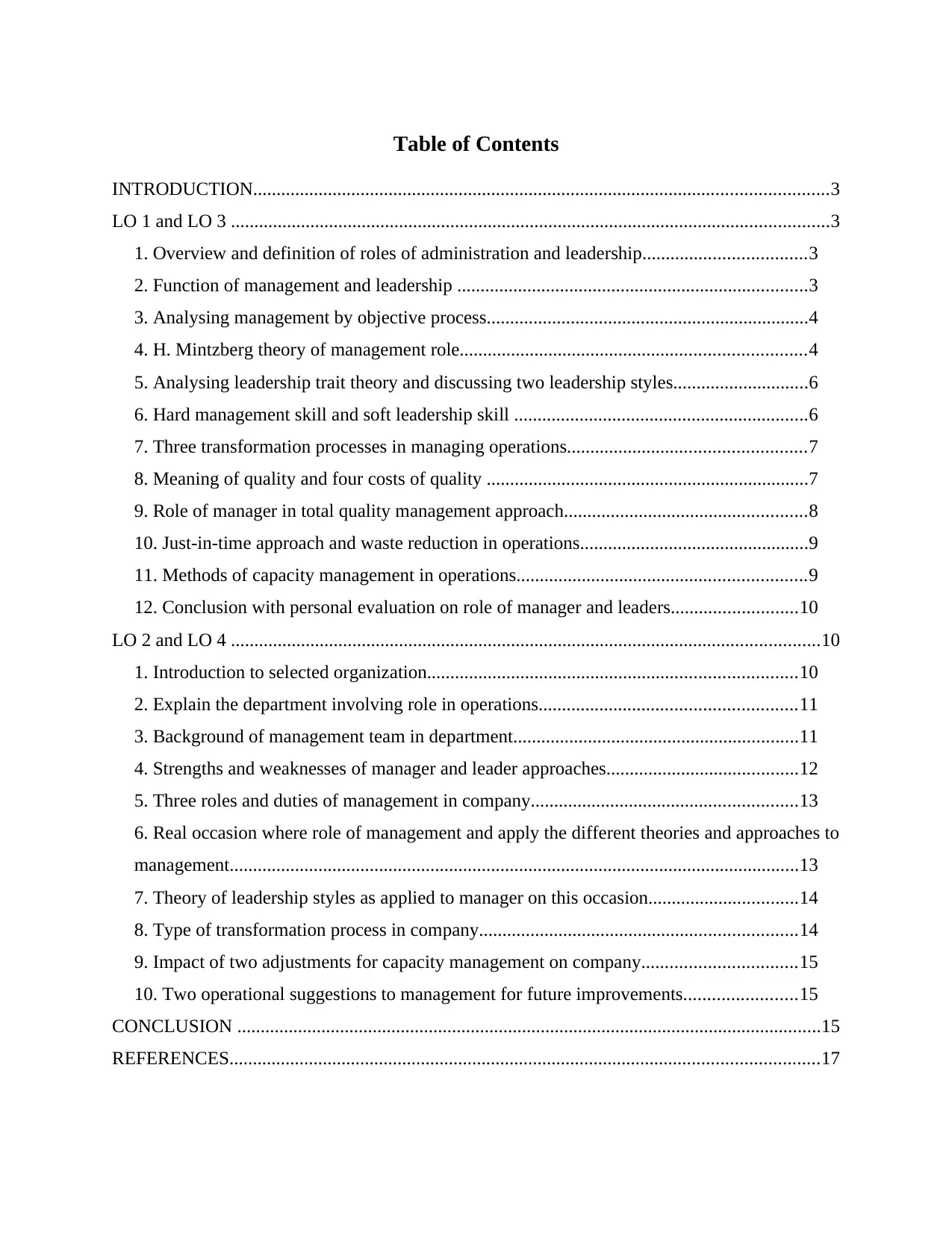
Table of Contents
INTRODUCTION...........................................................................................................................3
LO 1 and LO 3 ................................................................................................................................3
1. Overview and definition of roles of administration and leadership...................................3
2. Function of management and leadership ...........................................................................3
3. Analysing management by objective process.....................................................................4
4. H. Mintzberg theory of management role..........................................................................4
5. Analysing leadership trait theory and discussing two leadership styles.............................6
6. Hard management skill and soft leadership skill ...............................................................6
7. Three transformation processes in managing operations...................................................7
8. Meaning of quality and four costs of quality .....................................................................7
9. Role of manager in total quality management approach....................................................8
10. Just-in-time approach and waste reduction in operations.................................................9
11. Methods of capacity management in operations..............................................................9
12. Conclusion with personal evaluation on role of manager and leaders...........................10
LO 2 and LO 4 ..............................................................................................................................10
1. Introduction to selected organization...............................................................................10
2. Explain the department involving role in operations.......................................................11
3. Background of management team in department.............................................................11
4. Strengths and weaknesses of manager and leader approaches.........................................12
5. Three roles and duties of management in company.........................................................13
6. Real occasion where role of management and apply the different theories and approaches to
management..........................................................................................................................13
7. Theory of leadership styles as applied to manager on this occasion................................14
8. Type of transformation process in company....................................................................14
9. Impact of two adjustments for capacity management on company.................................15
10. Two operational suggestions to management for future improvements........................15
CONCLUSION .............................................................................................................................15
REFERENCES..............................................................................................................................17
INTRODUCTION...........................................................................................................................3
LO 1 and LO 3 ................................................................................................................................3
1. Overview and definition of roles of administration and leadership...................................3
2. Function of management and leadership ...........................................................................3
3. Analysing management by objective process.....................................................................4
4. H. Mintzberg theory of management role..........................................................................4
5. Analysing leadership trait theory and discussing two leadership styles.............................6
6. Hard management skill and soft leadership skill ...............................................................6
7. Three transformation processes in managing operations...................................................7
8. Meaning of quality and four costs of quality .....................................................................7
9. Role of manager in total quality management approach....................................................8
10. Just-in-time approach and waste reduction in operations.................................................9
11. Methods of capacity management in operations..............................................................9
12. Conclusion with personal evaluation on role of manager and leaders...........................10
LO 2 and LO 4 ..............................................................................................................................10
1. Introduction to selected organization...............................................................................10
2. Explain the department involving role in operations.......................................................11
3. Background of management team in department.............................................................11
4. Strengths and weaknesses of manager and leader approaches.........................................12
5. Three roles and duties of management in company.........................................................13
6. Real occasion where role of management and apply the different theories and approaches to
management..........................................................................................................................13
7. Theory of leadership styles as applied to manager on this occasion................................14
8. Type of transformation process in company....................................................................14
9. Impact of two adjustments for capacity management on company.................................15
10. Two operational suggestions to management for future improvements........................15
CONCLUSION .............................................................................................................................15
REFERENCES..............................................................................................................................17
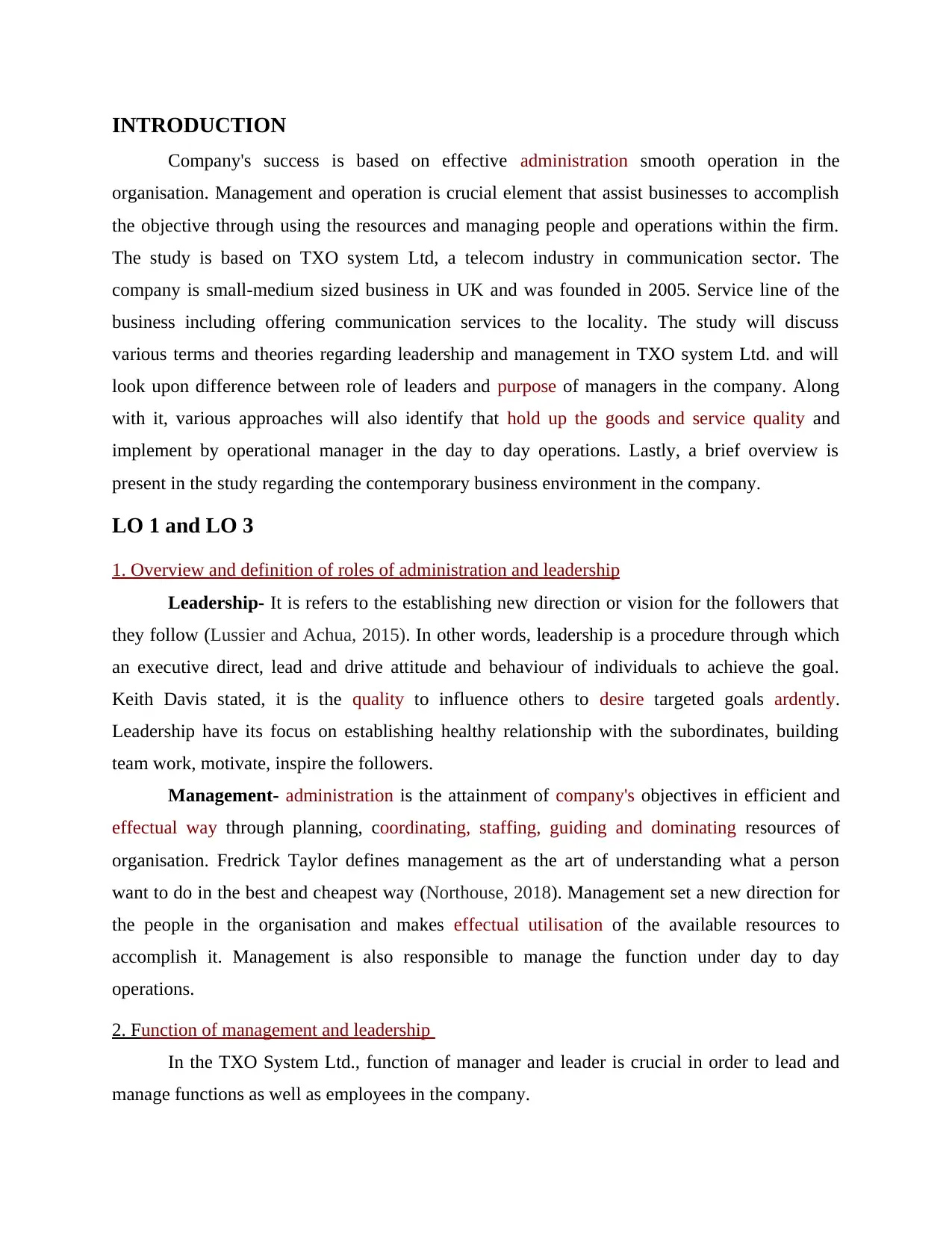
INTRODUCTION
Company's success is based on effective administration smooth operation in the
organisation. Management and operation is crucial element that assist businesses to accomplish
the objective through using the resources and managing people and operations within the firm.
The study is based on TXO system Ltd, a telecom industry in communication sector. The
company is small-medium sized business in UK and was founded in 2005. Service line of the
business including offering communication services to the locality. The study will discuss
various terms and theories regarding leadership and management in TXO system Ltd. and will
look upon difference between role of leaders and purpose of managers in the company. Along
with it, various approaches will also identify that hold up the goods and service quality and
implement by operational manager in the day to day operations. Lastly, a brief overview is
present in the study regarding the contemporary business environment in the company.
LO 1 and LO 3
1. Overview and definition of roles of administration and leadership
Leadership- It is refers to the establishing new direction or vision for the followers that
they follow (Lussier and Achua, 2015). In other words, leadership is a procedure through which
an executive direct, lead and drive attitude and behaviour of individuals to achieve the goal.
Keith Davis stated, it is the quality to influence others to desire targeted goals ardently.
Leadership have its focus on establishing healthy relationship with the subordinates, building
team work, motivate, inspire the followers.
Management- administration is the attainment of company's objectives in efficient and
effectual way through planning, coordinating, staffing, guiding and dominating resources of
organisation. Fredrick Taylor defines management as the art of understanding what a person
want to do in the best and cheapest way (Northouse, 2018). Management set a new direction for
the people in the organisation and makes effectual utilisation of the available resources to
accomplish it. Management is also responsible to manage the function under day to day
operations.
2. Function of management and leadership
In the TXO System Ltd., function of manager and leader is crucial in order to lead and
manage functions as well as employees in the company.
Company's success is based on effective administration smooth operation in the
organisation. Management and operation is crucial element that assist businesses to accomplish
the objective through using the resources and managing people and operations within the firm.
The study is based on TXO system Ltd, a telecom industry in communication sector. The
company is small-medium sized business in UK and was founded in 2005. Service line of the
business including offering communication services to the locality. The study will discuss
various terms and theories regarding leadership and management in TXO system Ltd. and will
look upon difference between role of leaders and purpose of managers in the company. Along
with it, various approaches will also identify that hold up the goods and service quality and
implement by operational manager in the day to day operations. Lastly, a brief overview is
present in the study regarding the contemporary business environment in the company.
LO 1 and LO 3
1. Overview and definition of roles of administration and leadership
Leadership- It is refers to the establishing new direction or vision for the followers that
they follow (Lussier and Achua, 2015). In other words, leadership is a procedure through which
an executive direct, lead and drive attitude and behaviour of individuals to achieve the goal.
Keith Davis stated, it is the quality to influence others to desire targeted goals ardently.
Leadership have its focus on establishing healthy relationship with the subordinates, building
team work, motivate, inspire the followers.
Management- administration is the attainment of company's objectives in efficient and
effectual way through planning, coordinating, staffing, guiding and dominating resources of
organisation. Fredrick Taylor defines management as the art of understanding what a person
want to do in the best and cheapest way (Northouse, 2018). Management set a new direction for
the people in the organisation and makes effectual utilisation of the available resources to
accomplish it. Management is also responsible to manage the function under day to day
operations.
2. Function of management and leadership
In the TXO System Ltd., function of manager and leader is crucial in order to lead and
manage functions as well as employees in the company.
⊘ This is a preview!⊘
Do you want full access?
Subscribe today to unlock all pages.

Trusted by 1+ million students worldwide
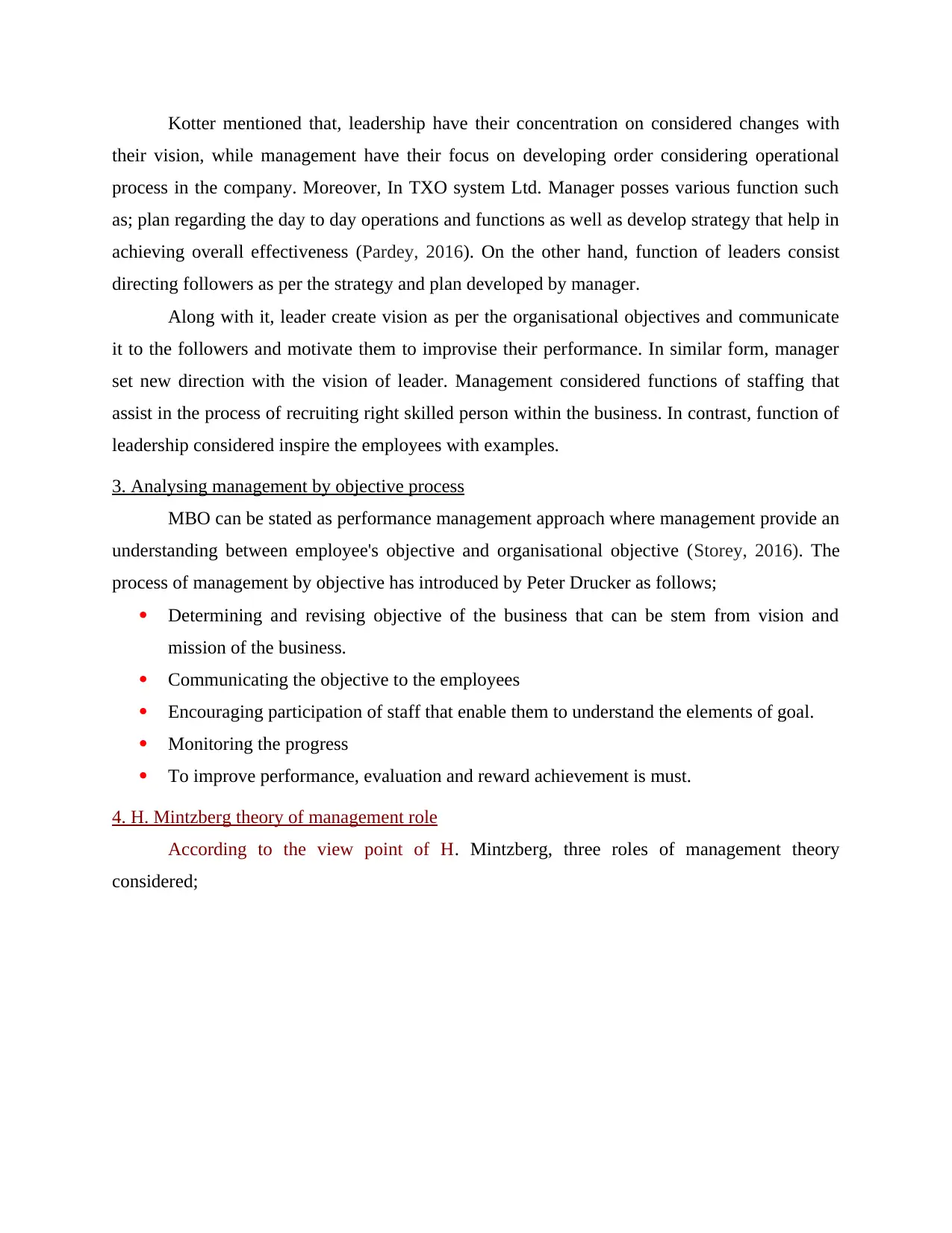
Kotter mentioned that, leadership have their concentration on considered changes with
their vision, while management have their focus on developing order considering operational
process in the company. Moreover, In TXO system Ltd. Manager posses various function such
as; plan regarding the day to day operations and functions as well as develop strategy that help in
achieving overall effectiveness (Pardey, 2016). On the other hand, function of leaders consist
directing followers as per the strategy and plan developed by manager.
Along with it, leader create vision as per the organisational objectives and communicate
it to the followers and motivate them to improvise their performance. In similar form, manager
set new direction with the vision of leader. Management considered functions of staffing that
assist in the process of recruiting right skilled person within the business. In contrast, function of
leadership considered inspire the employees with examples.
3. Analysing management by objective process
MBO can be stated as performance management approach where management provide an
understanding between employee's objective and organisational objective (Storey, 2016). The
process of management by objective has introduced by Peter Drucker as follows;
Determining and revising objective of the business that can be stem from vision and
mission of the business.
Communicating the objective to the employees
Encouraging participation of staff that enable them to understand the elements of goal.
Monitoring the progress
To improve performance, evaluation and reward achievement is must.
4. H. Mintzberg theory of management role
According to the view point of H. Mintzberg, three roles of management theory
considered;
their vision, while management have their focus on developing order considering operational
process in the company. Moreover, In TXO system Ltd. Manager posses various function such
as; plan regarding the day to day operations and functions as well as develop strategy that help in
achieving overall effectiveness (Pardey, 2016). On the other hand, function of leaders consist
directing followers as per the strategy and plan developed by manager.
Along with it, leader create vision as per the organisational objectives and communicate
it to the followers and motivate them to improvise their performance. In similar form, manager
set new direction with the vision of leader. Management considered functions of staffing that
assist in the process of recruiting right skilled person within the business. In contrast, function of
leadership considered inspire the employees with examples.
3. Analysing management by objective process
MBO can be stated as performance management approach where management provide an
understanding between employee's objective and organisational objective (Storey, 2016). The
process of management by objective has introduced by Peter Drucker as follows;
Determining and revising objective of the business that can be stem from vision and
mission of the business.
Communicating the objective to the employees
Encouraging participation of staff that enable them to understand the elements of goal.
Monitoring the progress
To improve performance, evaluation and reward achievement is must.
4. H. Mintzberg theory of management role
According to the view point of H. Mintzberg, three roles of management theory
considered;
Paraphrase This Document
Need a fresh take? Get an instant paraphrase of this document with our AI Paraphraser

Informational role: Role of management under the informational role considered
monitoring, scattering and spoke person (Pardey, 2016). Under this role, manager
monitoring seek internal and external information, transmit the information within the
industry and represent the company providing affected information to outsiders on behalf
of the company.
Interpersonal role: As per this role, manager of TXO System Ltd should perform all
feature of a good leader; establishing team, motivating, providing coaching and building
strong relationship. Manager also perform the role of intermediary and link high levels to
low levels.
Decisional role: management who have this type of role in nature are responsible to take
correct and effective actions after involve all the possible aspects that encourage change
regarding innovation and allocate necessary resources to the followers (Northouse, 2018).
In TXO management also perform the role of negotiator that is essential for the effective
outcome.
5. Analysing leadership trait theory and discussing two leadership styles
Trait theory of leadership is based on the characteristics of leaders that should have in the
individual in TXO System Ltd. This theory considered on identifying various characteristics and
personality traits that is essential in a successful leader. This is an effective hypothesis in the
company that posses two leadership style;
Illustration 1: Manager's Role
monitoring, scattering and spoke person (Pardey, 2016). Under this role, manager
monitoring seek internal and external information, transmit the information within the
industry and represent the company providing affected information to outsiders on behalf
of the company.
Interpersonal role: As per this role, manager of TXO System Ltd should perform all
feature of a good leader; establishing team, motivating, providing coaching and building
strong relationship. Manager also perform the role of intermediary and link high levels to
low levels.
Decisional role: management who have this type of role in nature are responsible to take
correct and effective actions after involve all the possible aspects that encourage change
regarding innovation and allocate necessary resources to the followers (Northouse, 2018).
In TXO management also perform the role of negotiator that is essential for the effective
outcome.
5. Analysing leadership trait theory and discussing two leadership styles
Trait theory of leadership is based on the characteristics of leaders that should have in the
individual in TXO System Ltd. This theory considered on identifying various characteristics and
personality traits that is essential in a successful leader. This is an effective hypothesis in the
company that posses two leadership style;
Illustration 1: Manager's Role
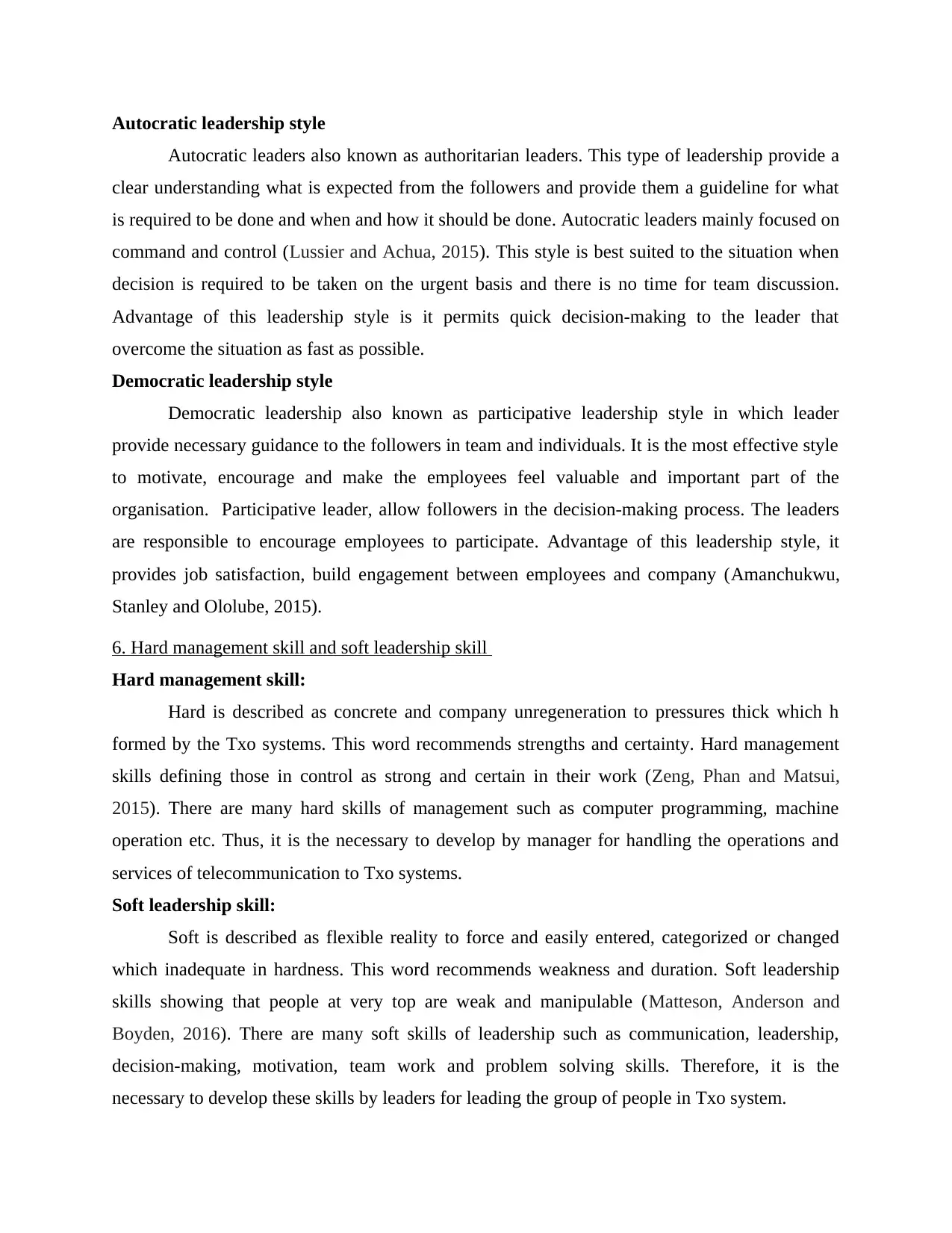
Autocratic leadership style
Autocratic leaders also known as authoritarian leaders. This type of leadership provide a
clear understanding what is expected from the followers and provide them a guideline for what
is required to be done and when and how it should be done. Autocratic leaders mainly focused on
command and control (Lussier and Achua, 2015). This style is best suited to the situation when
decision is required to be taken on the urgent basis and there is no time for team discussion.
Advantage of this leadership style is it permits quick decision-making to the leader that
overcome the situation as fast as possible.
Democratic leadership style
Democratic leadership also known as participative leadership style in which leader
provide necessary guidance to the followers in team and individuals. It is the most effective style
to motivate, encourage and make the employees feel valuable and important part of the
organisation. Participative leader, allow followers in the decision-making process. The leaders
are responsible to encourage employees to participate. Advantage of this leadership style, it
provides job satisfaction, build engagement between employees and company (Amanchukwu,
Stanley and Ololube, 2015).
6. Hard management skill and soft leadership skill
Hard management skill:
Hard is described as concrete and company unregeneration to pressures thick which h
formed by the Txo systems. This word recommends strengths and certainty. Hard management
skills defining those in control as strong and certain in their work (Zeng, Phan and Matsui,
2015). There are many hard skills of management such as computer programming, machine
operation etc. Thus, it is the necessary to develop by manager for handling the operations and
services of telecommunication to Txo systems.
Soft leadership skill:
Soft is described as flexible reality to force and easily entered, categorized or changed
which inadequate in hardness. This word recommends weakness and duration. Soft leadership
skills showing that people at very top are weak and manipulable (Matteson, Anderson and
Boyden, 2016). There are many soft skills of leadership such as communication, leadership,
decision-making, motivation, team work and problem solving skills. Therefore, it is the
necessary to develop these skills by leaders for leading the group of people in Txo system.
Autocratic leaders also known as authoritarian leaders. This type of leadership provide a
clear understanding what is expected from the followers and provide them a guideline for what
is required to be done and when and how it should be done. Autocratic leaders mainly focused on
command and control (Lussier and Achua, 2015). This style is best suited to the situation when
decision is required to be taken on the urgent basis and there is no time for team discussion.
Advantage of this leadership style is it permits quick decision-making to the leader that
overcome the situation as fast as possible.
Democratic leadership style
Democratic leadership also known as participative leadership style in which leader
provide necessary guidance to the followers in team and individuals. It is the most effective style
to motivate, encourage and make the employees feel valuable and important part of the
organisation. Participative leader, allow followers in the decision-making process. The leaders
are responsible to encourage employees to participate. Advantage of this leadership style, it
provides job satisfaction, build engagement between employees and company (Amanchukwu,
Stanley and Ololube, 2015).
6. Hard management skill and soft leadership skill
Hard management skill:
Hard is described as concrete and company unregeneration to pressures thick which h
formed by the Txo systems. This word recommends strengths and certainty. Hard management
skills defining those in control as strong and certain in their work (Zeng, Phan and Matsui,
2015). There are many hard skills of management such as computer programming, machine
operation etc. Thus, it is the necessary to develop by manager for handling the operations and
services of telecommunication to Txo systems.
Soft leadership skill:
Soft is described as flexible reality to force and easily entered, categorized or changed
which inadequate in hardness. This word recommends weakness and duration. Soft leadership
skills showing that people at very top are weak and manipulable (Matteson, Anderson and
Boyden, 2016). There are many soft skills of leadership such as communication, leadership,
decision-making, motivation, team work and problem solving skills. Therefore, it is the
necessary to develop these skills by leaders for leading the group of people in Txo system.
⊘ This is a preview!⊘
Do you want full access?
Subscribe today to unlock all pages.

Trusted by 1+ million students worldwide
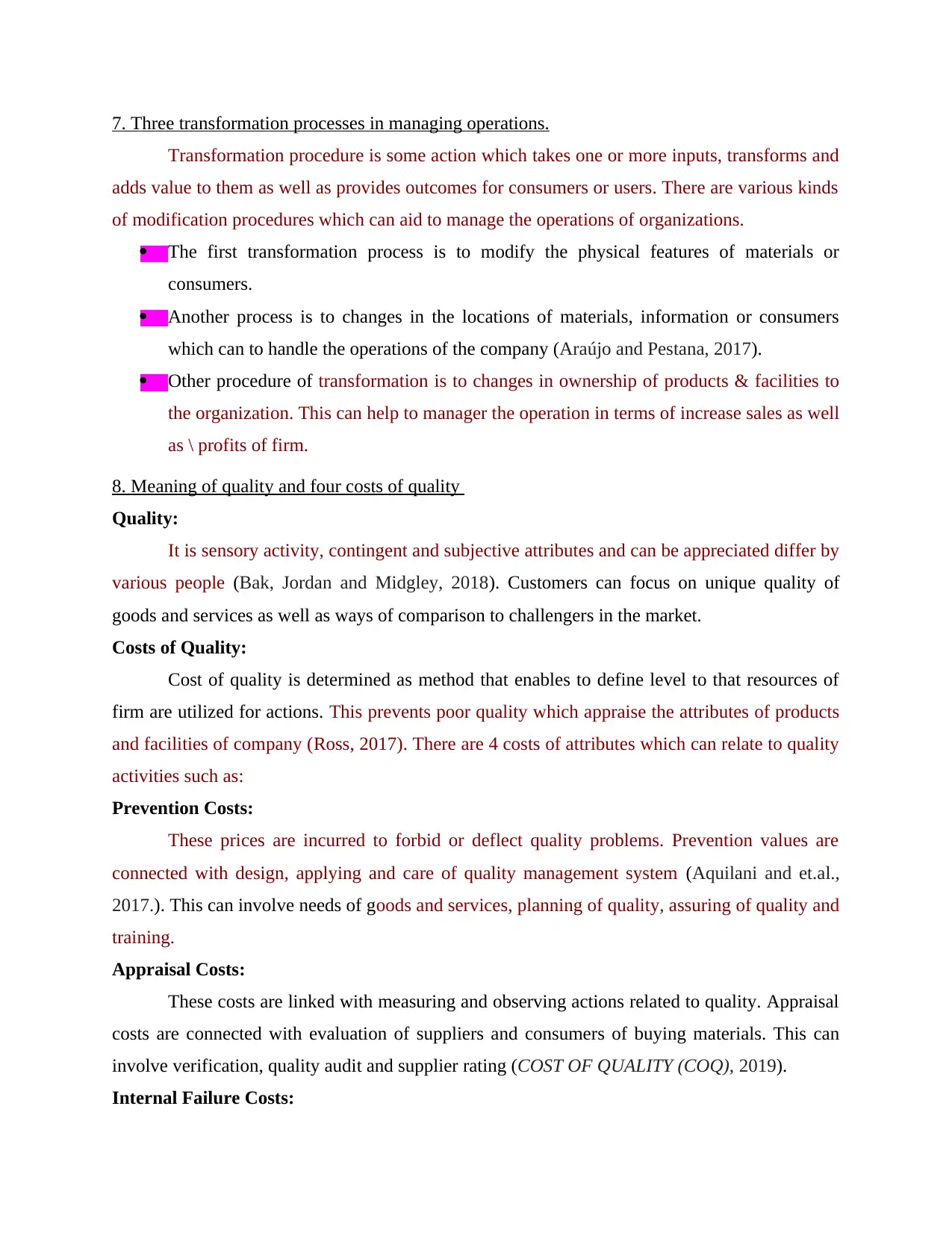
7. Three transformation processes in managing operations.
Transformation procedure is some action which takes one or more inputs, transforms and
adds value to them as well as provides outcomes for consumers or users. There are various kinds
of modification procedures which can aid to manage the operations of organizations.
The first transformation process is to modify the physical features of materials or
consumers.
Another process is to changes in the locations of materials, information or consumers
which can to handle the operations of the company (Araújo and Pestana, 2017).
Other procedure of transformation is to changes in ownership of products & facilities to
the organization. This can help to manager the operation in terms of increase sales as well
as \ profits of firm.
8. Meaning of quality and four costs of quality
Quality:
It is sensory activity, contingent and subjective attributes and can be appreciated differ by
various people (Bak, Jordan and Midgley, 2018). Customers can focus on unique quality of
goods and services as well as ways of comparison to challengers in the market.
Costs of Quality:
Cost of quality is determined as method that enables to define level to that resources of
firm are utilized for actions. This prevents poor quality which appraise the attributes of products
and facilities of company (Ross, 2017). There are 4 costs of attributes which can relate to quality
activities such as:
Prevention Costs:
These prices are incurred to forbid or deflect quality problems. Prevention values are
connected with design, applying and care of quality management system (Aquilani and et.al.,
2017.). This can involve needs of goods and services, planning of quality, assuring of quality and
training.
Appraisal Costs:
These costs are linked with measuring and observing actions related to quality. Appraisal
costs are connected with evaluation of suppliers and consumers of buying materials. This can
involve verification, quality audit and supplier rating (COST OF QUALITY (COQ), 2019).
Internal Failure Costs:
Transformation procedure is some action which takes one or more inputs, transforms and
adds value to them as well as provides outcomes for consumers or users. There are various kinds
of modification procedures which can aid to manage the operations of organizations.
The first transformation process is to modify the physical features of materials or
consumers.
Another process is to changes in the locations of materials, information or consumers
which can to handle the operations of the company (Araújo and Pestana, 2017).
Other procedure of transformation is to changes in ownership of products & facilities to
the organization. This can help to manager the operation in terms of increase sales as well
as \ profits of firm.
8. Meaning of quality and four costs of quality
Quality:
It is sensory activity, contingent and subjective attributes and can be appreciated differ by
various people (Bak, Jordan and Midgley, 2018). Customers can focus on unique quality of
goods and services as well as ways of comparison to challengers in the market.
Costs of Quality:
Cost of quality is determined as method that enables to define level to that resources of
firm are utilized for actions. This prevents poor quality which appraise the attributes of products
and facilities of company (Ross, 2017). There are 4 costs of attributes which can relate to quality
activities such as:
Prevention Costs:
These prices are incurred to forbid or deflect quality problems. Prevention values are
connected with design, applying and care of quality management system (Aquilani and et.al.,
2017.). This can involve needs of goods and services, planning of quality, assuring of quality and
training.
Appraisal Costs:
These costs are linked with measuring and observing actions related to quality. Appraisal
costs are connected with evaluation of suppliers and consumers of buying materials. This can
involve verification, quality audit and supplier rating (COST OF QUALITY (COQ), 2019).
Internal Failure Costs:
Paraphrase This Document
Need a fresh take? Get an instant paraphrase of this document with our AI Paraphraser

These costs are founded to correction faults before goods or services is delivered to the
consumers. Internal failure costs happen when outcomes of work failure to reach design quality
standards. These can involve waste, scrap, rework or refinement, analysis of failure (Jiménez-
Jiménez and et.al., 2015).
External Failure Costs:
These costs are founded to correction faults by consumers. External failure costs happen
when goods or facilities which failure to accomplish design and quality regulations are not
noticed until after transfer to consumers (Harris, Intelligence and Healthcare, 2017.). This can
involve repair and servicing, warranty claims, complaints and returns.
9. Role of manager in total quality management approach.
Total Quality Management (TQM):
TQM is defined as management concept to longer term attainment via consumer
satisfaction. Each the employees involved in modifying process, products, services and culture in
that they work in total quality management efforts (Ning and Sobel, 2017). There are many
principles of total quality management such as consumers-focused, total worker participation,
process-focused, integrated system, strategical or systematic concept, constant betterment, fact
based decision-making and interactions.
Role of Manager in TQM:
Manager play various roles in the total quality management which can aid to
development of small and medium company like Txo System.
Manager requires getting trained in different practices of total quality management before
applying the same (Yan and et.al., 2018).
The responsibility of director is to assign budgets for TQM at the starting of every
financial year.
As manager, it is duty to choose and nominate suitable candidates who can work as line
managers and take charges of the whole task.
10. Just-in-time approach and waste reduction in operations.
Just-in-time Approach (JIT):
JIT inventory system is direction approach that adjusts natural materials orders from
providers straight with manufacture time period. Organizations like Txo system utilize stock
concept to increase efficiency & reduce the waste by acquiring goods only as they require them
consumers. Internal failure costs happen when outcomes of work failure to reach design quality
standards. These can involve waste, scrap, rework or refinement, analysis of failure (Jiménez-
Jiménez and et.al., 2015).
External Failure Costs:
These costs are founded to correction faults by consumers. External failure costs happen
when goods or facilities which failure to accomplish design and quality regulations are not
noticed until after transfer to consumers (Harris, Intelligence and Healthcare, 2017.). This can
involve repair and servicing, warranty claims, complaints and returns.
9. Role of manager in total quality management approach.
Total Quality Management (TQM):
TQM is defined as management concept to longer term attainment via consumer
satisfaction. Each the employees involved in modifying process, products, services and culture in
that they work in total quality management efforts (Ning and Sobel, 2017). There are many
principles of total quality management such as consumers-focused, total worker participation,
process-focused, integrated system, strategical or systematic concept, constant betterment, fact
based decision-making and interactions.
Role of Manager in TQM:
Manager play various roles in the total quality management which can aid to
development of small and medium company like Txo System.
Manager requires getting trained in different practices of total quality management before
applying the same (Yan and et.al., 2018).
The responsibility of director is to assign budgets for TQM at the starting of every
financial year.
As manager, it is duty to choose and nominate suitable candidates who can work as line
managers and take charges of the whole task.
10. Just-in-time approach and waste reduction in operations.
Just-in-time Approach (JIT):
JIT inventory system is direction approach that adjusts natural materials orders from
providers straight with manufacture time period. Organizations like Txo system utilize stock
concept to increase efficiency & reduce the waste by acquiring goods only as they require them
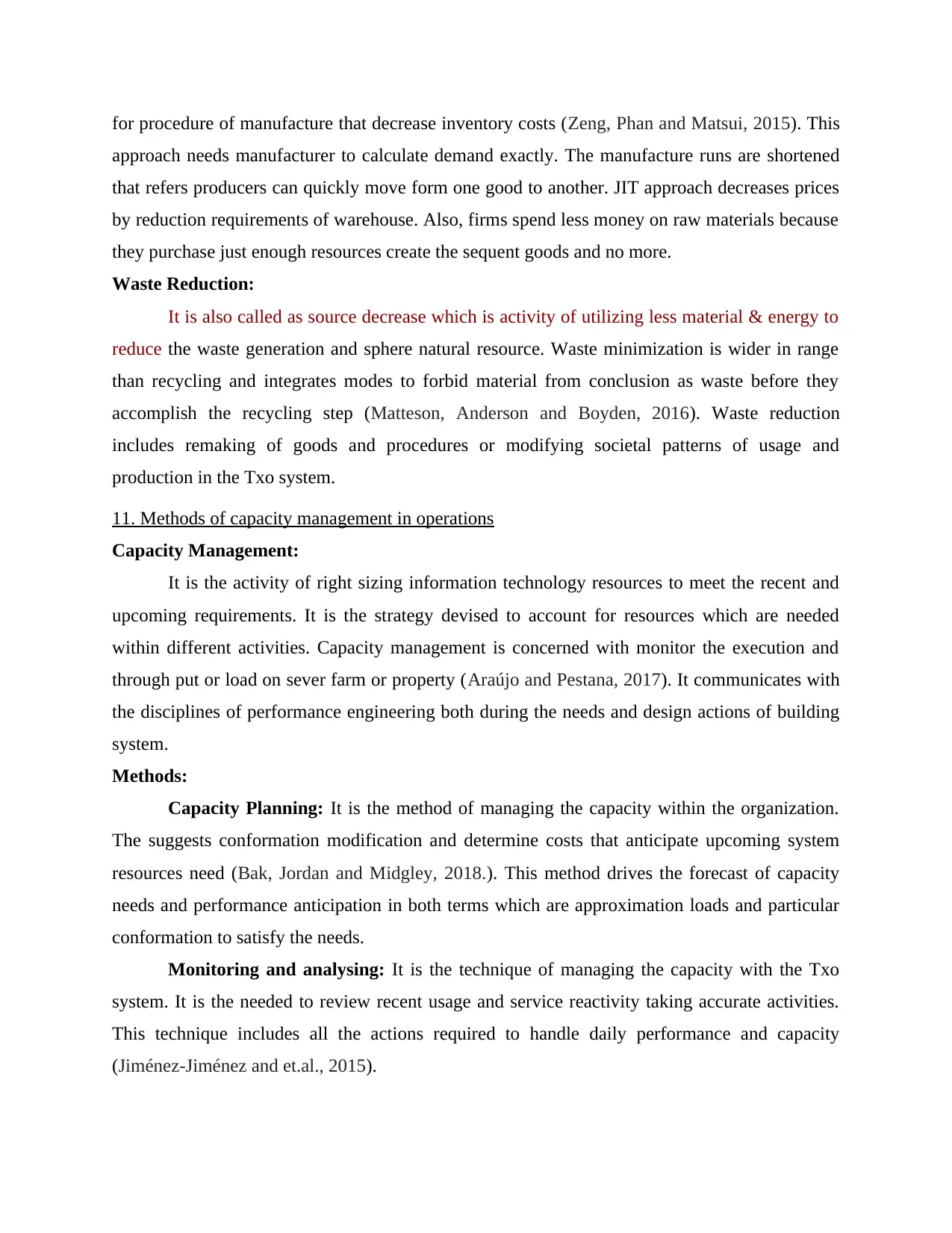
for procedure of manufacture that decrease inventory costs (Zeng, Phan and Matsui, 2015). This
approach needs manufacturer to calculate demand exactly. The manufacture runs are shortened
that refers producers can quickly move form one good to another. JIT approach decreases prices
by reduction requirements of warehouse. Also, firms spend less money on raw materials because
they purchase just enough resources create the sequent goods and no more.
Waste Reduction:
It is also called as source decrease which is activity of utilizing less material & energy to
reduce the waste generation and sphere natural resource. Waste minimization is wider in range
than recycling and integrates modes to forbid material from conclusion as waste before they
accomplish the recycling step (Matteson, Anderson and Boyden, 2016). Waste reduction
includes remaking of goods and procedures or modifying societal patterns of usage and
production in the Txo system.
11. Methods of capacity management in operations
Capacity Management:
It is the activity of right sizing information technology resources to meet the recent and
upcoming requirements. It is the strategy devised to account for resources which are needed
within different activities. Capacity management is concerned with monitor the execution and
through put or load on sever farm or property (Araújo and Pestana, 2017). It communicates with
the disciplines of performance engineering both during the needs and design actions of building
system.
Methods:
Capacity Planning: It is the method of managing the capacity within the organization.
The suggests conformation modification and determine costs that anticipate upcoming system
resources need (Bak, Jordan and Midgley, 2018.). This method drives the forecast of capacity
needs and performance anticipation in both terms which are approximation loads and particular
conformation to satisfy the needs.
Monitoring and analysing: It is the technique of managing the capacity with the Txo
system. It is the needed to review recent usage and service reactivity taking accurate activities.
This technique includes all the actions required to handle daily performance and capacity
(Jiménez-Jiménez and et.al., 2015).
approach needs manufacturer to calculate demand exactly. The manufacture runs are shortened
that refers producers can quickly move form one good to another. JIT approach decreases prices
by reduction requirements of warehouse. Also, firms spend less money on raw materials because
they purchase just enough resources create the sequent goods and no more.
Waste Reduction:
It is also called as source decrease which is activity of utilizing less material & energy to
reduce the waste generation and sphere natural resource. Waste minimization is wider in range
than recycling and integrates modes to forbid material from conclusion as waste before they
accomplish the recycling step (Matteson, Anderson and Boyden, 2016). Waste reduction
includes remaking of goods and procedures or modifying societal patterns of usage and
production in the Txo system.
11. Methods of capacity management in operations
Capacity Management:
It is the activity of right sizing information technology resources to meet the recent and
upcoming requirements. It is the strategy devised to account for resources which are needed
within different activities. Capacity management is concerned with monitor the execution and
through put or load on sever farm or property (Araújo and Pestana, 2017). It communicates with
the disciplines of performance engineering both during the needs and design actions of building
system.
Methods:
Capacity Planning: It is the method of managing the capacity within the organization.
The suggests conformation modification and determine costs that anticipate upcoming system
resources need (Bak, Jordan and Midgley, 2018.). This method drives the forecast of capacity
needs and performance anticipation in both terms which are approximation loads and particular
conformation to satisfy the needs.
Monitoring and analysing: It is the technique of managing the capacity with the Txo
system. It is the needed to review recent usage and service reactivity taking accurate activities.
This technique includes all the actions required to handle daily performance and capacity
(Jiménez-Jiménez and et.al., 2015).
⊘ This is a preview!⊘
Do you want full access?
Subscribe today to unlock all pages.

Trusted by 1+ million students worldwide
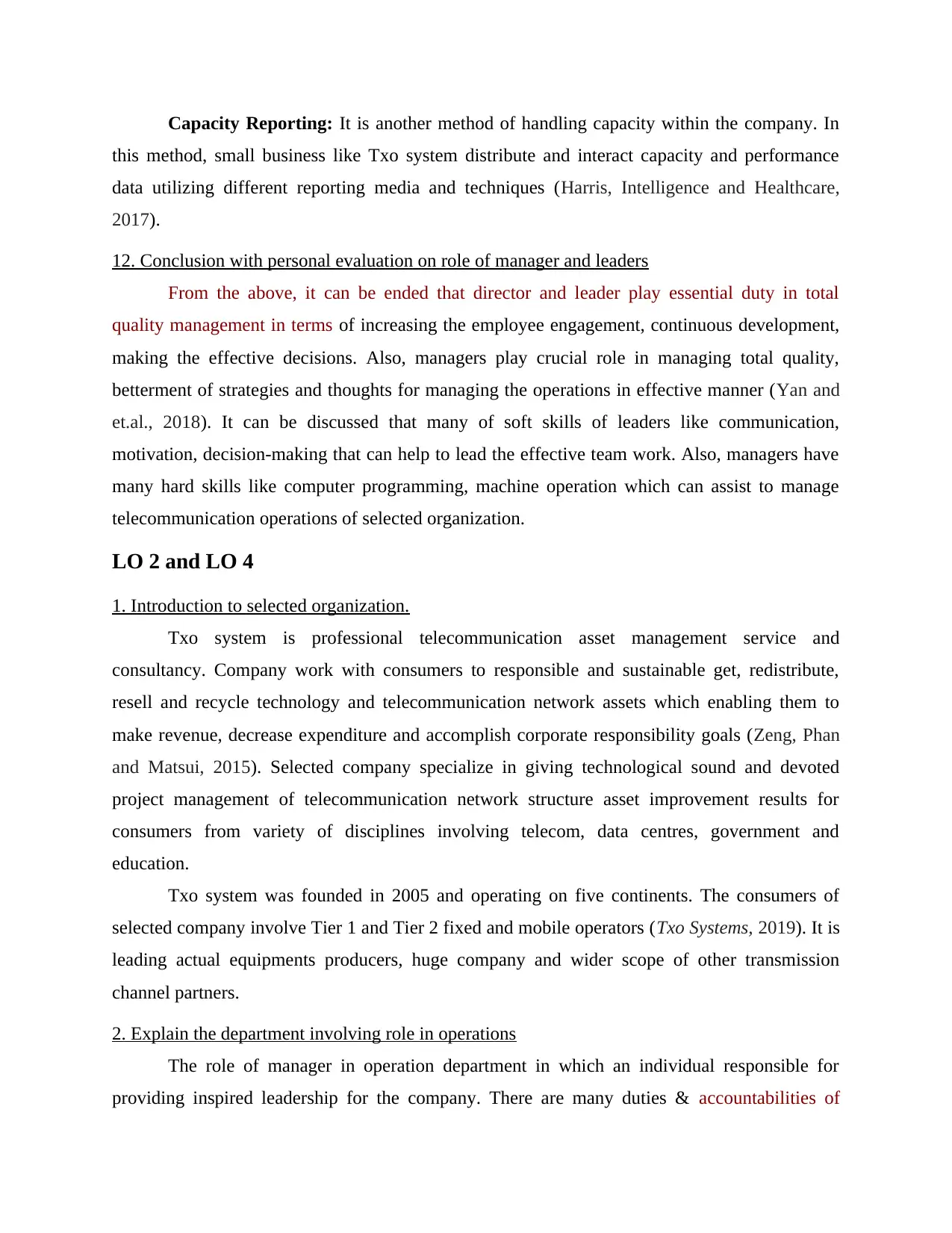
Capacity Reporting: It is another method of handling capacity within the company. In
this method, small business like Txo system distribute and interact capacity and performance
data utilizing different reporting media and techniques (Harris, Intelligence and Healthcare,
2017).
12. Conclusion with personal evaluation on role of manager and leaders
From the above, it can be ended that director and leader play essential duty in total
quality management in terms of increasing the employee engagement, continuous development,
making the effective decisions. Also, managers play crucial role in managing total quality,
betterment of strategies and thoughts for managing the operations in effective manner (Yan and
et.al., 2018). It can be discussed that many of soft skills of leaders like communication,
motivation, decision-making that can help to lead the effective team work. Also, managers have
many hard skills like computer programming, machine operation which can assist to manage
telecommunication operations of selected organization.
LO 2 and LO 4
1. Introduction to selected organization.
Txo system is professional telecommunication asset management service and
consultancy. Company work with consumers to responsible and sustainable get, redistribute,
resell and recycle technology and telecommunication network assets which enabling them to
make revenue, decrease expenditure and accomplish corporate responsibility goals (Zeng, Phan
and Matsui, 2015). Selected company specialize in giving technological sound and devoted
project management of telecommunication network structure asset improvement results for
consumers from variety of disciplines involving telecom, data centres, government and
education.
Txo system was founded in 2005 and operating on five continents. The consumers of
selected company involve Tier 1 and Tier 2 fixed and mobile operators (Txo Systems, 2019). It is
leading actual equipments producers, huge company and wider scope of other transmission
channel partners.
2. Explain the department involving role in operations
The role of manager in operation department in which an individual responsible for
providing inspired leadership for the company. There are many duties & accountabilities of
this method, small business like Txo system distribute and interact capacity and performance
data utilizing different reporting media and techniques (Harris, Intelligence and Healthcare,
2017).
12. Conclusion with personal evaluation on role of manager and leaders
From the above, it can be ended that director and leader play essential duty in total
quality management in terms of increasing the employee engagement, continuous development,
making the effective decisions. Also, managers play crucial role in managing total quality,
betterment of strategies and thoughts for managing the operations in effective manner (Yan and
et.al., 2018). It can be discussed that many of soft skills of leaders like communication,
motivation, decision-making that can help to lead the effective team work. Also, managers have
many hard skills like computer programming, machine operation which can assist to manage
telecommunication operations of selected organization.
LO 2 and LO 4
1. Introduction to selected organization.
Txo system is professional telecommunication asset management service and
consultancy. Company work with consumers to responsible and sustainable get, redistribute,
resell and recycle technology and telecommunication network assets which enabling them to
make revenue, decrease expenditure and accomplish corporate responsibility goals (Zeng, Phan
and Matsui, 2015). Selected company specialize in giving technological sound and devoted
project management of telecommunication network structure asset improvement results for
consumers from variety of disciplines involving telecom, data centres, government and
education.
Txo system was founded in 2005 and operating on five continents. The consumers of
selected company involve Tier 1 and Tier 2 fixed and mobile operators (Txo Systems, 2019). It is
leading actual equipments producers, huge company and wider scope of other transmission
channel partners.
2. Explain the department involving role in operations
The role of manager in operation department in which an individual responsible for
providing inspired leadership for the company. There are many duties & accountabilities of
Paraphrase This Document
Need a fresh take? Get an instant paraphrase of this document with our AI Paraphraser
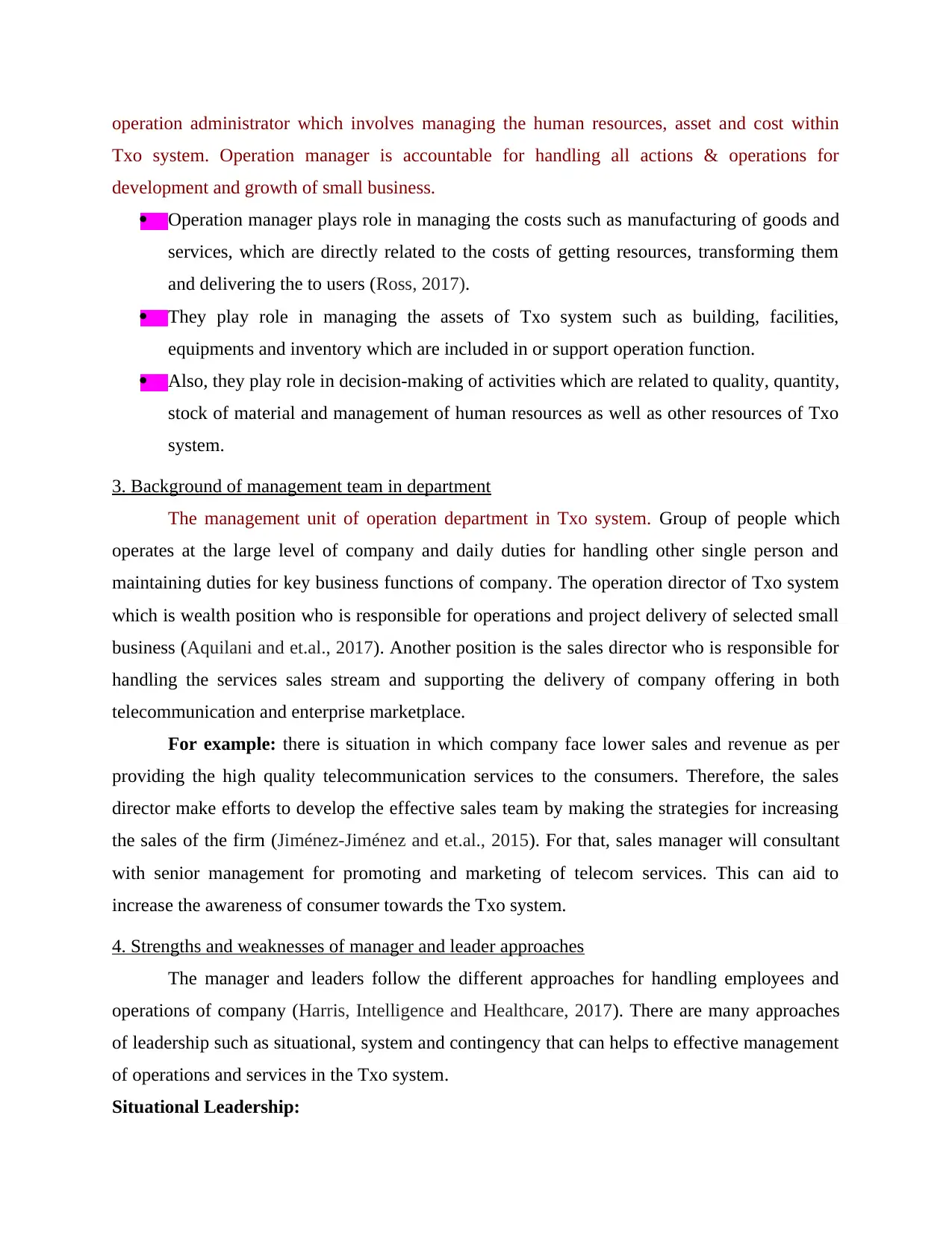
operation administrator which involves managing the human resources, asset and cost within
Txo system. Operation manager is accountable for handling all actions & operations for
development and growth of small business.
Operation manager plays role in managing the costs such as manufacturing of goods and
services, which are directly related to the costs of getting resources, transforming them
and delivering the to users (Ross, 2017).
They play role in managing the assets of Txo system such as building, facilities,
equipments and inventory which are included in or support operation function.
Also, they play role in decision-making of activities which are related to quality, quantity,
stock of material and management of human resources as well as other resources of Txo
system.
3. Background of management team in department
The management unit of operation department in Txo system. Group of people which
operates at the large level of company and daily duties for handling other single person and
maintaining duties for key business functions of company. The operation director of Txo system
which is wealth position who is responsible for operations and project delivery of selected small
business (Aquilani and et.al., 2017). Another position is the sales director who is responsible for
handling the services sales stream and supporting the delivery of company offering in both
telecommunication and enterprise marketplace.
For example: there is situation in which company face lower sales and revenue as per
providing the high quality telecommunication services to the consumers. Therefore, the sales
director make efforts to develop the effective sales team by making the strategies for increasing
the sales of the firm (Jiménez-Jiménez and et.al., 2015). For that, sales manager will consultant
with senior management for promoting and marketing of telecom services. This can aid to
increase the awareness of consumer towards the Txo system.
4. Strengths and weaknesses of manager and leader approaches
The manager and leaders follow the different approaches for handling employees and
operations of company (Harris, Intelligence and Healthcare, 2017). There are many approaches
of leadership such as situational, system and contingency that can helps to effective management
of operations and services in the Txo system.
Situational Leadership:
Txo system. Operation manager is accountable for handling all actions & operations for
development and growth of small business.
Operation manager plays role in managing the costs such as manufacturing of goods and
services, which are directly related to the costs of getting resources, transforming them
and delivering the to users (Ross, 2017).
They play role in managing the assets of Txo system such as building, facilities,
equipments and inventory which are included in or support operation function.
Also, they play role in decision-making of activities which are related to quality, quantity,
stock of material and management of human resources as well as other resources of Txo
system.
3. Background of management team in department
The management unit of operation department in Txo system. Group of people which
operates at the large level of company and daily duties for handling other single person and
maintaining duties for key business functions of company. The operation director of Txo system
which is wealth position who is responsible for operations and project delivery of selected small
business (Aquilani and et.al., 2017). Another position is the sales director who is responsible for
handling the services sales stream and supporting the delivery of company offering in both
telecommunication and enterprise marketplace.
For example: there is situation in which company face lower sales and revenue as per
providing the high quality telecommunication services to the consumers. Therefore, the sales
director make efforts to develop the effective sales team by making the strategies for increasing
the sales of the firm (Jiménez-Jiménez and et.al., 2015). For that, sales manager will consultant
with senior management for promoting and marketing of telecom services. This can aid to
increase the awareness of consumer towards the Txo system.
4. Strengths and weaknesses of manager and leader approaches
The manager and leaders follow the different approaches for handling employees and
operations of company (Harris, Intelligence and Healthcare, 2017). There are many approaches
of leadership such as situational, system and contingency that can helps to effective management
of operations and services in the Txo system.
Situational Leadership:

It is the leadership style and approach which means to when leaders or managers of
company must modify their style to suitable the improvement flat of followers that they are
difficult to effect. This leading model is timeless, quotable method for leaders to match their
attitudes with the performance requirements of single or team which they are trying to effect
(Ning and Sobel, 2017).
Strengths:
Situational leaders can move unstable from one style to another which is based on the
condition and nature of tasks.
This leadership approach is easy to understand and self-generated to most managers in
Txo system.
Weakness:
This kind of flexible approach to management can make too much emphasis on
immediate wants. Therefore, shift attention away from longer terms objectives of
company (Zeng, Phan and Matsui, 2015).
In this approach, emotional and job maturity are difficult to understand that can outcome
in conflation among two.
System Leadership:
This kind of leadership approach allows leaders or managers in Txo system to make
situations where group at each level can perform profitably to their expectation. It utilizes good
values about human attitudes to create models of effective leadership, strategy of company,
design systems and social procedure.
Strengths:
System leadership is focused on multiple dimensions of management in the Txo system.
It raises adaptability to environmental modifications in the company (Matteson,
Anderson and Boyden, 2016).
Weakness:
This kind of leadership style is very complex.
This type of leadership style can not be applicable to small-medium company.
company must modify their style to suitable the improvement flat of followers that they are
difficult to effect. This leading model is timeless, quotable method for leaders to match their
attitudes with the performance requirements of single or team which they are trying to effect
(Ning and Sobel, 2017).
Strengths:
Situational leaders can move unstable from one style to another which is based on the
condition and nature of tasks.
This leadership approach is easy to understand and self-generated to most managers in
Txo system.
Weakness:
This kind of flexible approach to management can make too much emphasis on
immediate wants. Therefore, shift attention away from longer terms objectives of
company (Zeng, Phan and Matsui, 2015).
In this approach, emotional and job maturity are difficult to understand that can outcome
in conflation among two.
System Leadership:
This kind of leadership approach allows leaders or managers in Txo system to make
situations where group at each level can perform profitably to their expectation. It utilizes good
values about human attitudes to create models of effective leadership, strategy of company,
design systems and social procedure.
Strengths:
System leadership is focused on multiple dimensions of management in the Txo system.
It raises adaptability to environmental modifications in the company (Matteson,
Anderson and Boyden, 2016).
Weakness:
This kind of leadership style is very complex.
This type of leadership style can not be applicable to small-medium company.
⊘ This is a preview!⊘
Do you want full access?
Subscribe today to unlock all pages.

Trusted by 1+ million students worldwide
1 out of 17
Related Documents
Your All-in-One AI-Powered Toolkit for Academic Success.
+13062052269
info@desklib.com
Available 24*7 on WhatsApp / Email
![[object Object]](/_next/static/media/star-bottom.7253800d.svg)
Unlock your academic potential
Copyright © 2020–2025 A2Z Services. All Rights Reserved. Developed and managed by ZUCOL.





